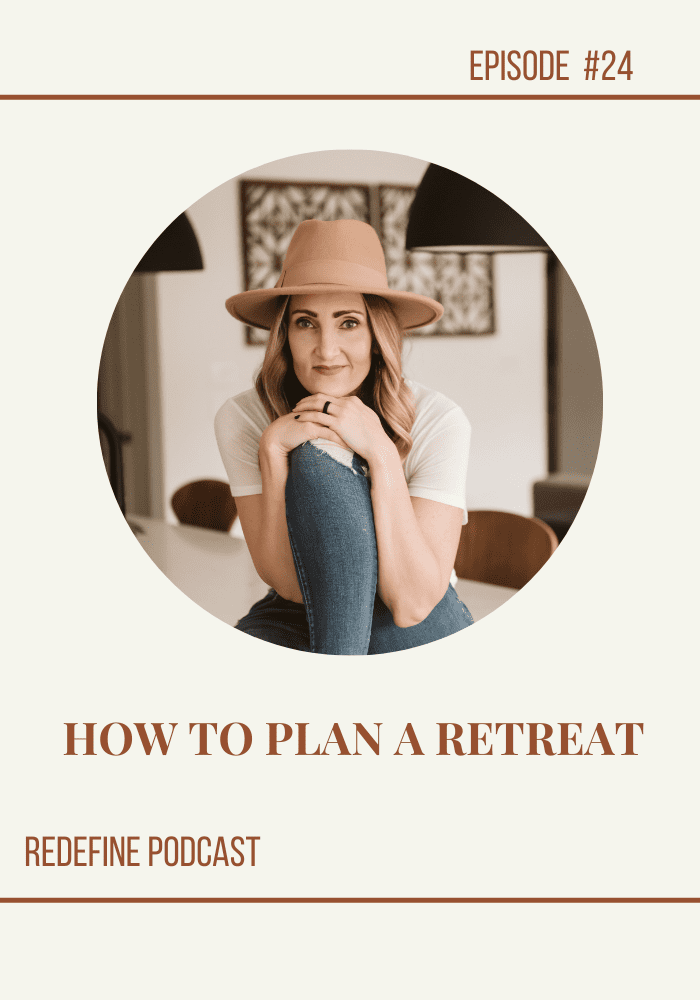
REDEFINE PODCAST
How to Plan a Retreat

Planning a Retreat
Earlier this year I planned a retreat. It was fabulous. There is nothing like spending the week with like-minded entrepreneurs. You walk away feeling inspired, motivated, and re-energized. You build friendships that last a lifetime because you connect on so many levels. They are amazing. If you haven’t attended a retreat, I highly recommend you put it on your bucket list. This is How to Plan a Retreat.
I currently have a client that is planning a retreat and I thought this would be a great podcast for those who are considering hosting a retreat or have it on their vision board to host a retreat one day.
I have included in the show notes a Retreat Planner Guide that will be really helpful when planning. I live and die for checklists, so if you enjoy a good checklist the way that I do you will find it very helpful.
First of all, let’s talk about the difference between a workshop, a conference, and a retreat.
WORKSHOPS
A workshop is a longer interactive meeting or educational session designed to create a result. Workshops are longer than the typical business meeting and require more preparation beforehand. They are usually designed around a specific topic. Workshops typically involve one presenter or several presenters. Workshops can be a few hours or an entire day.
Workshops give attendees the chance to practice their skills or learn new ones with help from the experts. Workshops may involve group discussions, exercises, activities, and the practical applications of concepts learned. You might say workshops are about “doing” rather than “listening” or “networking.”
Conferences
A conference is a large, more formal meeting of people with shared interests. It can include presentations, exhibitions, speakers, problem-solving sessions, and consultation sessions. Conferences are often used to bring together people who work within the same or similar industries, to connect buyers and sellers of certain types of products or services, or to network.
A conference theme will usually be broader than one single topic like a workshop, which tends to focus on a more specific and hands-on topic.
Conferences tend to be longer events than workshops. They can last several days or more and may have anywhere from 50 attendees to thousands of attendees. Conferences are a great way to network and see what is new in your industry.
RETREATS
People attend a retreat to learn, relax, rejuvenate, reflect, recharge and refocus. Retreats tend to have no more than 40 or 50 people. A business retreat is a live event where you experience the best of both worlds – work and vacation. Retreats have two sides and that’s deliberate. It’s the perfect blend between reflecting and recharging but getting to learn new things and developing your business skills. It’s not always heavy work but it’s an opportunity to make strides in your business. Retreats are also held in retreat-like areas. The location is usually tucked away somewhere that’s calming and retreat-like. Think a cool Airbnb in the woods with a runningstream nearby, a beach house on a beautiful coast or a cabin in the mountains with stellar views.
This event is usually one to three speakers. Retreats live up to their name when they’re filled with activities such as yoga, meditation, exercise, nature walks and other calming activities.
Now that I have talked about the differences, let’s dive into the details of the planning.
CHOOSING A DATE
The first thing you have to do when planning a retreat is decide a date. When you are deciding a date make sure to be aware of any holidays that might interfere with your dates. Be aware that when planning a retreat right before or right after a holiday it might conflict with people’s availability. If are planning a retreat for a specific industry that has a busy season and slow season be aware of that too.
For example, if you are planning a retreat for wedding photographers be mindful that they might not have time in the summer or spring, because that is peak wedding season. If you are planning a retreat for boutique owners you might want to avoid planning around Thanksgiving or December because that is peak shopping season.
DESTINATION
The next part of a retreat is finding an epic destination. Depending on the type of retreat you are hosting, but for the most part you want to make sure your retreat is at a place that is easy to get to. Destinations that are close to bigger airports makes it not only convenient, but also more cost effective for your guests. You might find an awesome location and venue, but if your guests have to pay as much for the airplane ticket and/or a car rental they may not be able to justify.
There is a caveat, if you have a solid brand your people would do anything to spend time with you even if it means taking out a mortgage on their home to spend a week with you in an epic destination.
LODGING
The next part of planning a retreat is finding an amazing lodging. This part of retreat planning is one of my simple pleasures. I could spend hours on Airbnb.com looking at cool locations in amazing destinations. There are so many jaw-dropping properties.
Because a retreat is typically something people go on to learn, relax, rejuvenate, reflect, recharge and refocus. With that being said you want to make sure your location provides enough space and also fits all your guests needs and expectations.
When choosing a location or venue you want to take into consideration the sleeping arrangements. A lot of retreats are done in larger homes or cabins so everyone is under the same roof. You might find an amazing house that sleeps 30-40 people, but that also might mean people have to share rooms and/or beds and some guests might not be okay with that.
The crucial part of the location planning is that if you determine that people have to share rooms you HAVE to be transparent and upfront about this information. If people do not want to share a room, you could offer a higher rate for a private room or discounted rate for a shared room. Either way you HAVE to let people know this information upfront.
Unless you plan on providing all the food, another thing to consider when choosing a location is proximity to restaurants, activities, and other amenities.
FOOD
We all love good food and this definitely can add to the experience, but if you are providing all the food for 30 people for entire week this cost can really add up.
Try to be cost effective with the food you provide. Consider providing breakfast, lunch and snacks, and let the guest be on their own for dinner. Dinner tends to be the most expensive meal of the day, and this can really add up, especially if you are providing alcohol. If you are in a location that has lots of restaurants close by you can meet up as a group or let your guests do their own thing.
SPEAKERS
If you decide to have speakers at your retreat, providing travel expenses and a speaking fee is the industry standard. When presenting the travel reimbursement research what the average flight costs are and offer a specific amount. That way your speakers will know that if they decide to upgrade their flight or wait until the last minute to book their flight, those extra expenses are their responsibility. If you have a lot of credit card points and prefer to book their flights for them that is an option as well.
The speaker fee can always be negotiated. The speaker might be willing to speak in trade for a spot at your retreat or for some great exposure. This part can be tricky, but respect other professionals and their time. If possible, provide a couple of different options and then agree on something that benefits both parties.
SPONSORS
Finding sponsors is a great way to help you cross-market, cut your costs, and provide swag to your attendees. Reach out to brands you have worked with or use in your business and ask if they would be willing to sponsor your retreat. Let them know what you do and who you serve and the details. The worse thing they can say is no, right?
When you host the retreat make a point to talk and show your appreciation for your sponsors and encourage all your attendees to talk about them on social media and tag them. Your sponsors will appreciate it and it will make them willing to sponsor you again in the future.
SWAG
The little details are so important to me. It helps create an awesome experience and by gifting your attendees little gifts it adds that extra little touch. If you can get your sponsors to send these gifts that is great, but if you opt not to get sponsors consider working a little gift into your budget.
PRICING
Let’s dive into how to price your retreat. Retreats are a lot of work and unless you are doing it out of the kindness of your heart, you want to make sure you make your desired profit. Pricing is often a tricky part for entrepreneurs. You are may not have some money mindset issues around what to charge, but you need to work through that. If you are providing value your ideal audience, be willing to pay for it.
The first thing you want to do when figuring out pricing is make a estimate of what you costs are going to be. Include lodging, food, supplies, travel, swag/gifts, speaker expenses, and any other expenses you might accrue. Give yourself a small budget for misc. expenses, because they will happen.
Once you have an estimate of what your costs will be decide how much you want to make. Then add your expenses with desired profit and then divide that number from how many available beds or rooms.
Let’s do an example:
15 available rooms/beds
Lodging for 4 days and 3 nights = $3000
Estimated food costs = $2000
Swag/Gifts – $500
Travel/Speaker expenses = $500
Total Expenses = $6000
Desired Profit = $10,000
Total =$16,000 expenses/15 rooms
I would need to charge $1066 each person to make the profit I want to make.
This is a good starting point, and you can play around with this pricing depending on if there are different options for private room or shared, but you know that on average you need to make this much in order to make your desired profit.
MARKETING
Now that you have all the details of the retreat planned and coordinated, now it’s time to sell it! It doesn’t matter how amazing your location is and how awesome your swag is if you can’t sell it out. It’s time to get to work and sell this thing!
NAME AND TAGLINE
Come up with a name for your retreat and a tagline that explains in 1-2 sentences who the retreat is for and what they can expect.
WEBSITE/SALES PAGE
Create a website or sales page that gives all the details of the retreat. You will want to include date, location, itinerary, details on lodging, food provided, education provided, speakers, and cost.
Provide as many details as possible impossible including your bio and speaker bios. Include pictures of the host, location, and anything else that will get them excited.
Include a call to action to grab their spot, then redirect them to the payment page.
SOCIAL MEDIA
Create graphics for all your social media platforms that hype people up and then redirect them to your sales page. Post these frequently until your retreat is full.
Talk about your retreat non-stop. Get people excited by showing them pictures and/or videos of the location. Talk about the benefit and create a sense of urgency so they don’t put it off.
NEWSLETTER
Send several newsletters to your email list letting them know they are the first to know. Consider offering an early bird discount or bonus for people already in your network.
Create a sense of urgency by using a countdown timer or letting them know there are limited spots available.
CROSS-MARKET
Ask your sponsors to share information about your retreat. Encourage attendees that sign up to share with their friends. Look for podcasts and/or interviews that will allow you to promote your retreat.
Create graphics and scripts/verbiage for your sponsors to use to make it easy and quick for them to promote.
COMMUNICATION
Prepare a series of emails for attendees that sign up. These emails include more details such as address of the location, airports options, what to expect, transportation to and from the retreat, weather, a detailed itinerary, what to pack, and anything else they need to know. There is no such thing as too much communication so if your retreat is 3 months away communicate with them regularly to get them excited.
You could also create a GROUPME that will allow all the attendees to communicate and ask questions. If people want to share a car rental, they can coordinate with the group. This is a great resource for attendees to get to know each other and start to create friendships.
Give yourself plenty of time to market your retreat. I would recommend at least 2-3 months. Talk about it and hype it up as much as possible.
Planning a retreat is a lot of work, but it’s so rewarding when you get to watch a group of like-minded people come together and forge friendships, become inspired, and walk away with excitement about what they gained from the retreat.
To get you started on planning your retreat I have included a Retreat Planning Guide in the show notes. If you have been considering hosting a retreat, do it! You will love it!
Click HERE to grab your guide.







